Attributes of a Research Paper: Components and Significance
VerifiedAdded on 2023/06/05
|14
|3522
|307
AI Summary
This case study analyzes the attributes of a good research paper. The discussion shall outline the various components of a research paper and their significance. The major components of a research paper comprise the cover page, abstract, introduction, methodology, results, discussion, conclusion, recommendations, and references. Each of these parts needs to be clear and effectively arranged to make the standard format of a research paper.
Contribute Materials
Your contribution can guide someone’s learning journey. Share your
documents today.
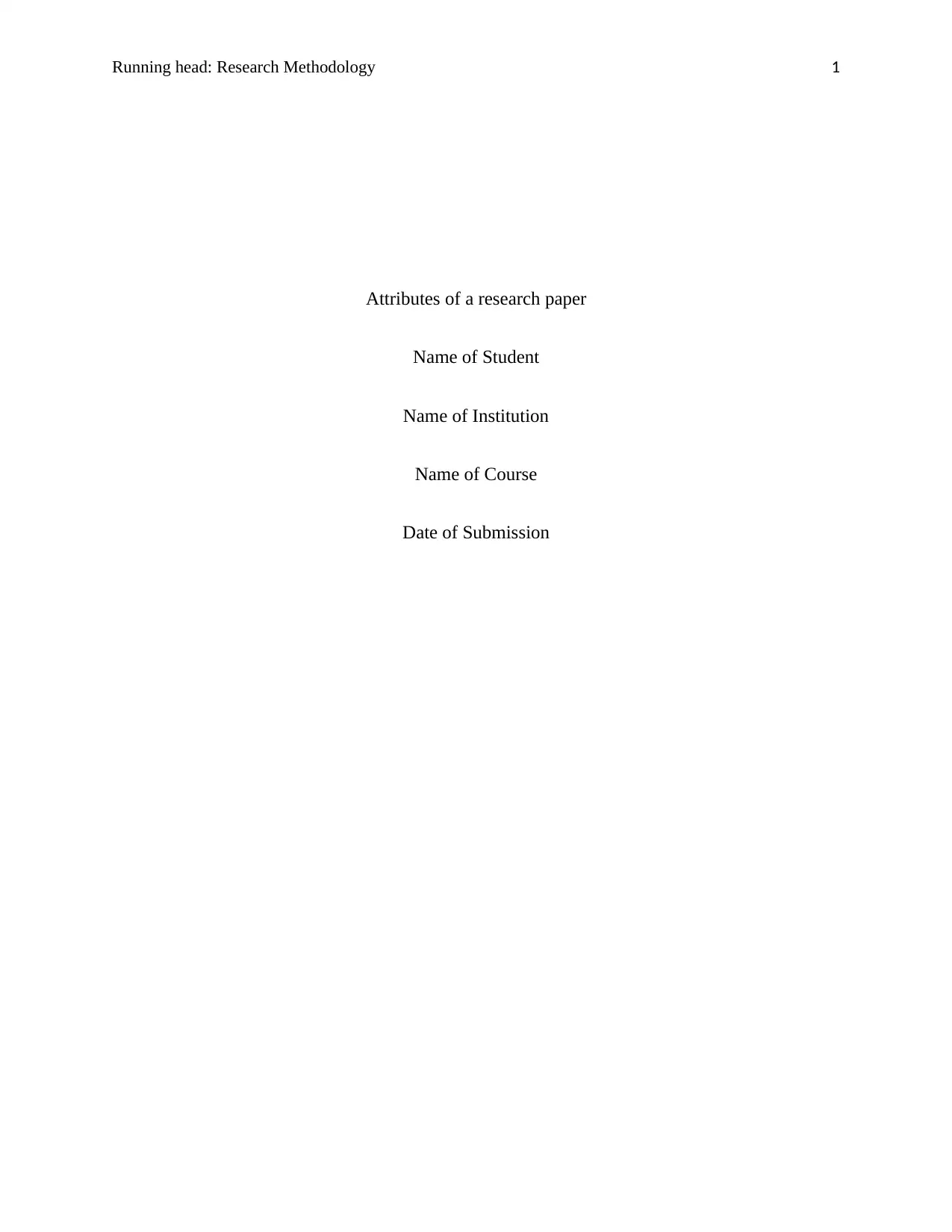
Running head: Research Methodology 1
Attributes of a research paper
Name of Student
Name of Institution
Name of Course
Date of Submission
Attributes of a research paper
Name of Student
Name of Institution
Name of Course
Date of Submission
Secure Best Marks with AI Grader
Need help grading? Try our AI Grader for instant feedback on your assignments.
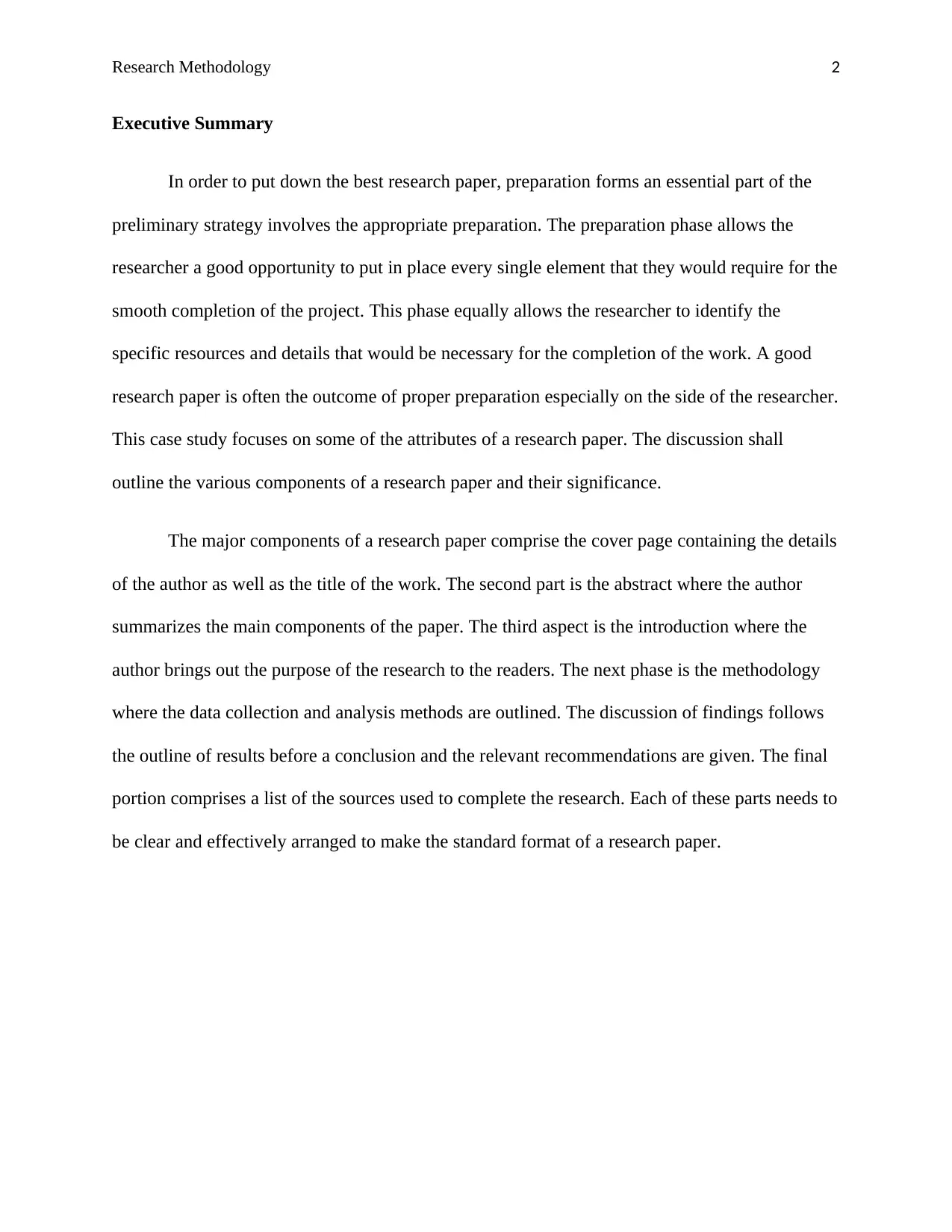
Research Methodology 2
Executive Summary
In order to put down the best research paper, preparation forms an essential part of the
preliminary strategy involves the appropriate preparation. The preparation phase allows the
researcher a good opportunity to put in place every single element that they would require for the
smooth completion of the project. This phase equally allows the researcher to identify the
specific resources and details that would be necessary for the completion of the work. A good
research paper is often the outcome of proper preparation especially on the side of the researcher.
This case study focuses on some of the attributes of a research paper. The discussion shall
outline the various components of a research paper and their significance.
The major components of a research paper comprise the cover page containing the details
of the author as well as the title of the work. The second part is the abstract where the author
summarizes the main components of the paper. The third aspect is the introduction where the
author brings out the purpose of the research to the readers. The next phase is the methodology
where the data collection and analysis methods are outlined. The discussion of findings follows
the outline of results before a conclusion and the relevant recommendations are given. The final
portion comprises a list of the sources used to complete the research. Each of these parts needs to
be clear and effectively arranged to make the standard format of a research paper.
Executive Summary
In order to put down the best research paper, preparation forms an essential part of the
preliminary strategy involves the appropriate preparation. The preparation phase allows the
researcher a good opportunity to put in place every single element that they would require for the
smooth completion of the project. This phase equally allows the researcher to identify the
specific resources and details that would be necessary for the completion of the work. A good
research paper is often the outcome of proper preparation especially on the side of the researcher.
This case study focuses on some of the attributes of a research paper. The discussion shall
outline the various components of a research paper and their significance.
The major components of a research paper comprise the cover page containing the details
of the author as well as the title of the work. The second part is the abstract where the author
summarizes the main components of the paper. The third aspect is the introduction where the
author brings out the purpose of the research to the readers. The next phase is the methodology
where the data collection and analysis methods are outlined. The discussion of findings follows
the outline of results before a conclusion and the relevant recommendations are given. The final
portion comprises a list of the sources used to complete the research. Each of these parts needs to
be clear and effectively arranged to make the standard format of a research paper.
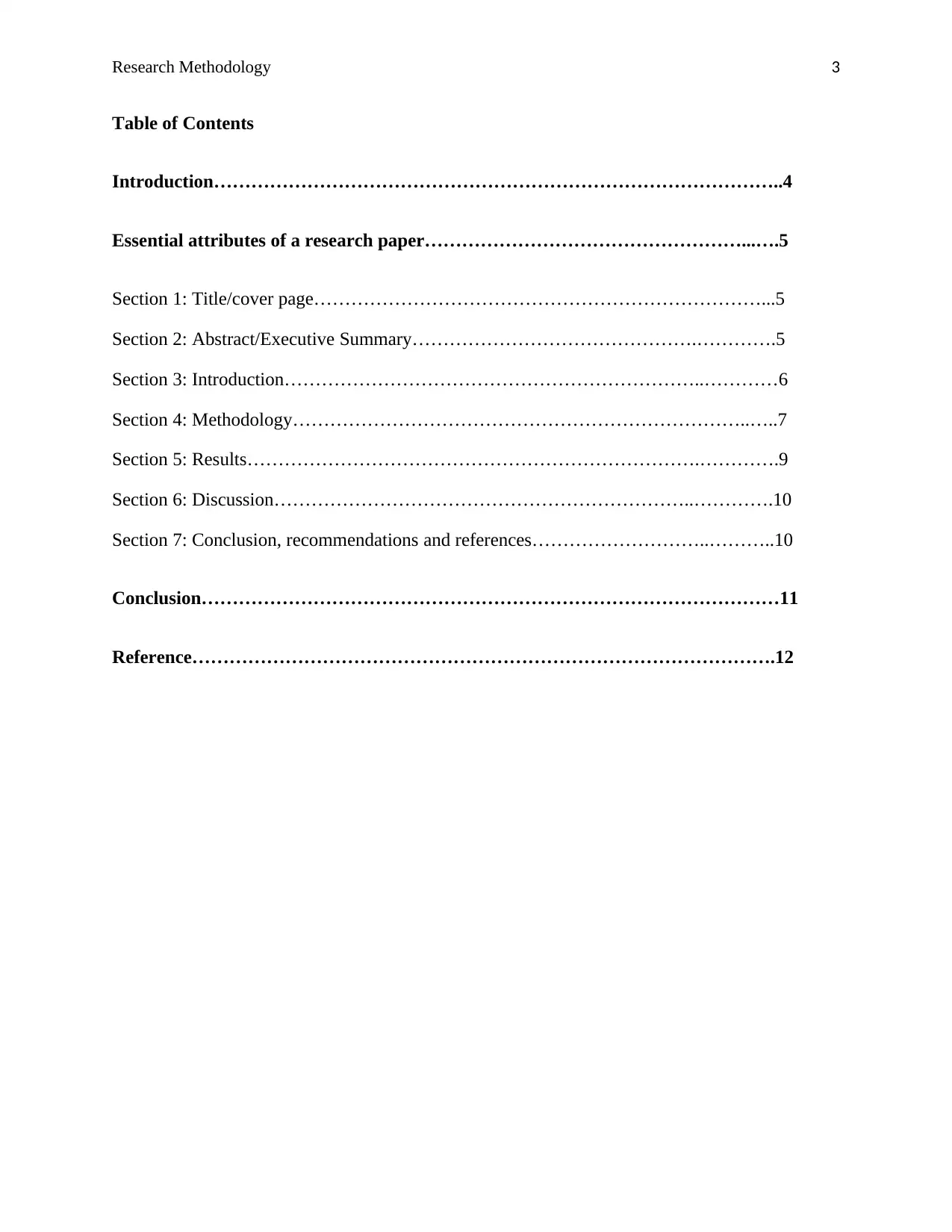
Research Methodology 3
Table of Contents
Introduction………………………………………………………………………………..4
Essential attributes of a research paper……………………………………………...….5
Section 1: Title/cover page………………………………………………………………...5
Section 2: Abstract/Executive Summary……………………………………….………….5
Section 3: Introduction…………………………………………………………..…………6
Section 4: Methodology………………………………………………………………..…..7
Section 5: Results……………………………………………………………….………….9
Section 6: Discussion…………………………………………………………..………….10
Section 7: Conclusion, recommendations and references………………………..………..10
Conclusion…………………………………………………………………………………11
Reference………………………………………………………………………………….12
Table of Contents
Introduction………………………………………………………………………………..4
Essential attributes of a research paper……………………………………………...….5
Section 1: Title/cover page………………………………………………………………...5
Section 2: Abstract/Executive Summary……………………………………….………….5
Section 3: Introduction…………………………………………………………..…………6
Section 4: Methodology………………………………………………………………..…..7
Section 5: Results……………………………………………………………….………….9
Section 6: Discussion…………………………………………………………..………….10
Section 7: Conclusion, recommendations and references………………………..………..10
Conclusion…………………………………………………………………………………11
Reference………………………………………………………………………………….12
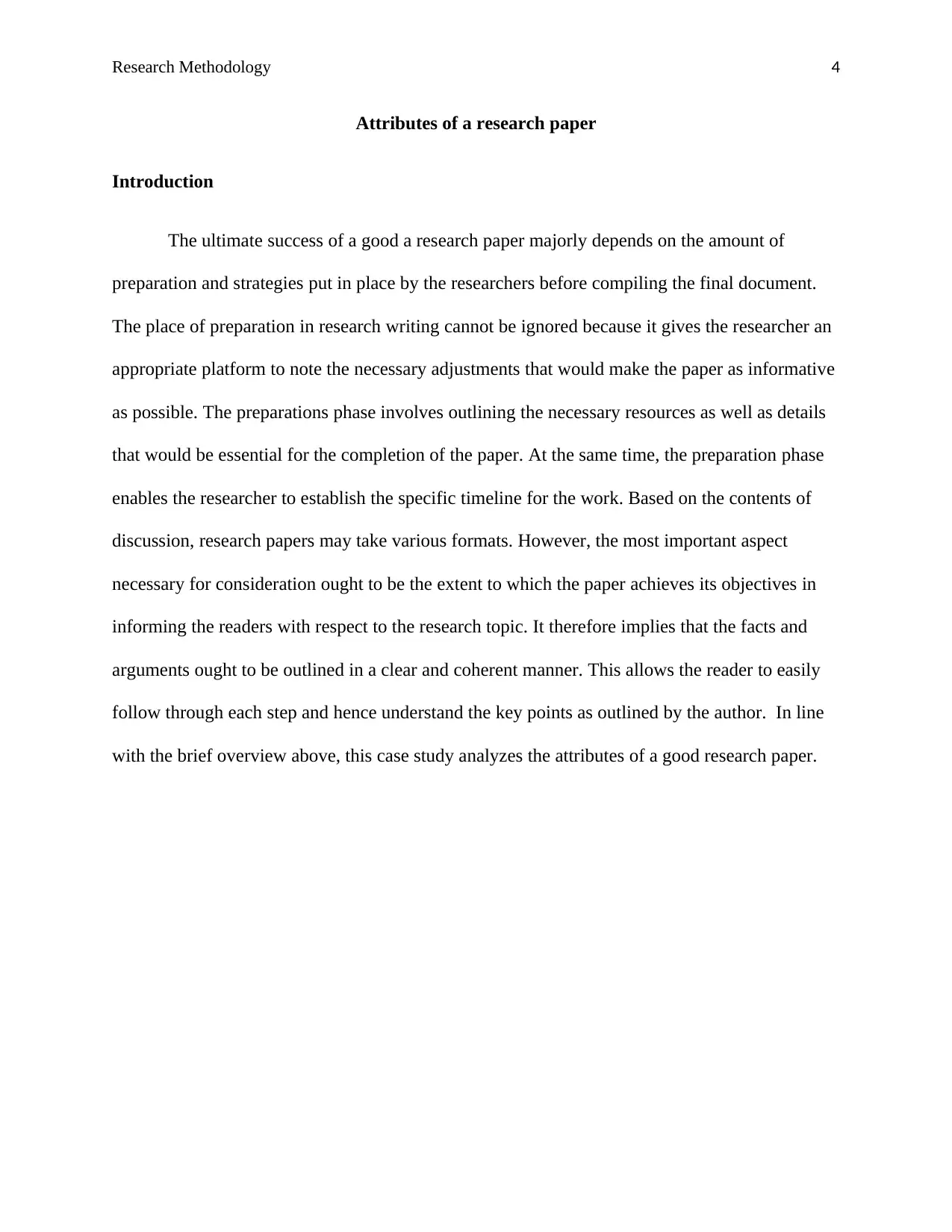
Research Methodology 4
Attributes of a research paper
Introduction
The ultimate success of a good a research paper majorly depends on the amount of
preparation and strategies put in place by the researchers before compiling the final document.
The place of preparation in research writing cannot be ignored because it gives the researcher an
appropriate platform to note the necessary adjustments that would make the paper as informative
as possible. The preparations phase involves outlining the necessary resources as well as details
that would be essential for the completion of the paper. At the same time, the preparation phase
enables the researcher to establish the specific timeline for the work. Based on the contents of
discussion, research papers may take various formats. However, the most important aspect
necessary for consideration ought to be the extent to which the paper achieves its objectives in
informing the readers with respect to the research topic. It therefore implies that the facts and
arguments ought to be outlined in a clear and coherent manner. This allows the reader to easily
follow through each step and hence understand the key points as outlined by the author. In line
with the brief overview above, this case study analyzes the attributes of a good research paper.
Attributes of a research paper
Introduction
The ultimate success of a good a research paper majorly depends on the amount of
preparation and strategies put in place by the researchers before compiling the final document.
The place of preparation in research writing cannot be ignored because it gives the researcher an
appropriate platform to note the necessary adjustments that would make the paper as informative
as possible. The preparations phase involves outlining the necessary resources as well as details
that would be essential for the completion of the paper. At the same time, the preparation phase
enables the researcher to establish the specific timeline for the work. Based on the contents of
discussion, research papers may take various formats. However, the most important aspect
necessary for consideration ought to be the extent to which the paper achieves its objectives in
informing the readers with respect to the research topic. It therefore implies that the facts and
arguments ought to be outlined in a clear and coherent manner. This allows the reader to easily
follow through each step and hence understand the key points as outlined by the author. In line
with the brief overview above, this case study analyzes the attributes of a good research paper.
Secure Best Marks with AI Grader
Need help grading? Try our AI Grader for instant feedback on your assignments.
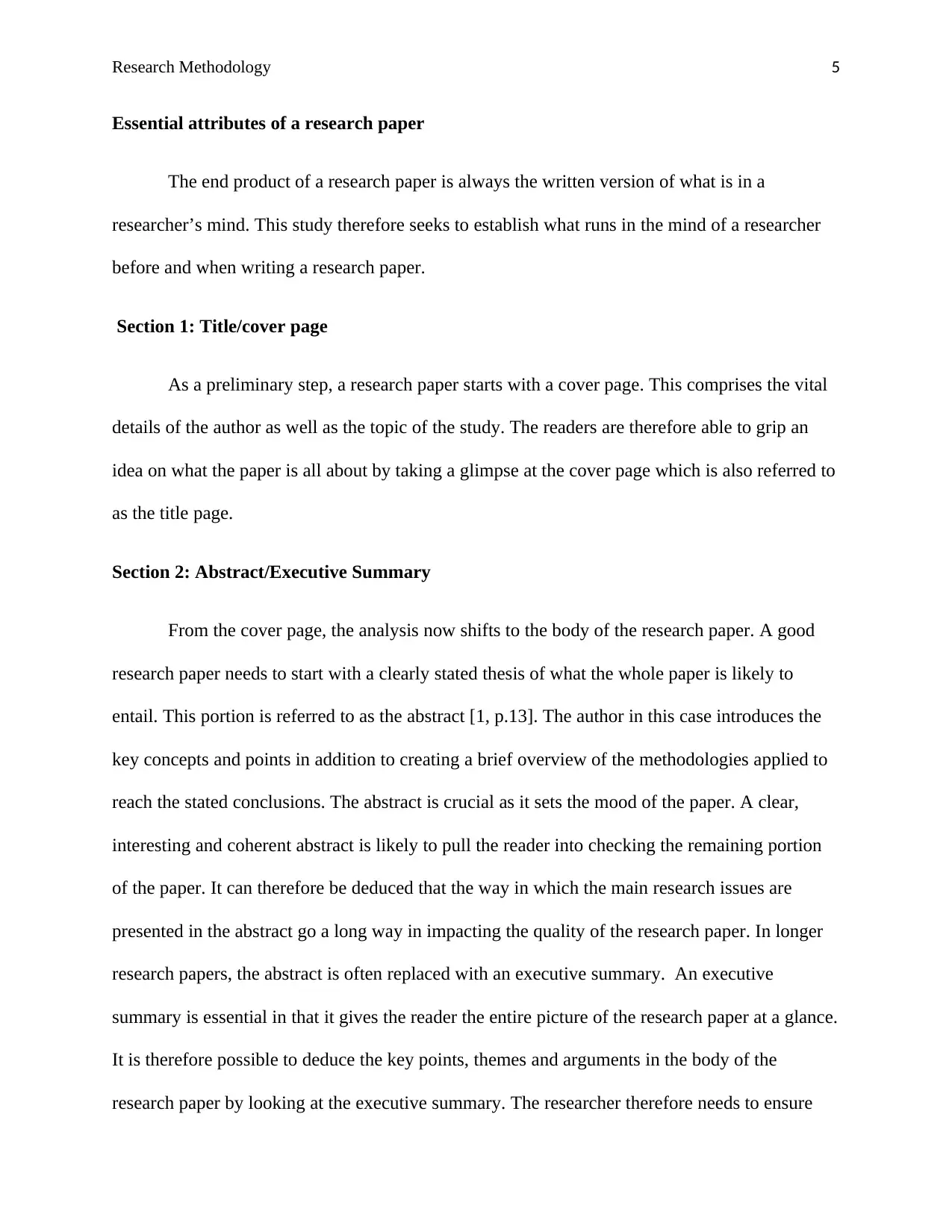
Research Methodology 5
Essential attributes of a research paper
The end product of a research paper is always the written version of what is in a
researcher’s mind. This study therefore seeks to establish what runs in the mind of a researcher
before and when writing a research paper.
Section 1: Title/cover page
As a preliminary step, a research paper starts with a cover page. This comprises the vital
details of the author as well as the topic of the study. The readers are therefore able to grip an
idea on what the paper is all about by taking a glimpse at the cover page which is also referred to
as the title page.
Section 2: Abstract/Executive Summary
From the cover page, the analysis now shifts to the body of the research paper. A good
research paper needs to start with a clearly stated thesis of what the whole paper is likely to
entail. This portion is referred to as the abstract [1, p.13]. The author in this case introduces the
key concepts and points in addition to creating a brief overview of the methodologies applied to
reach the stated conclusions. The abstract is crucial as it sets the mood of the paper. A clear,
interesting and coherent abstract is likely to pull the reader into checking the remaining portion
of the paper. It can therefore be deduced that the way in which the main research issues are
presented in the abstract go a long way in impacting the quality of the research paper. In longer
research papers, the abstract is often replaced with an executive summary. An executive
summary is essential in that it gives the reader the entire picture of the research paper at a glance.
It is therefore possible to deduce the key points, themes and arguments in the body of the
research paper by looking at the executive summary. The researcher therefore needs to ensure
Essential attributes of a research paper
The end product of a research paper is always the written version of what is in a
researcher’s mind. This study therefore seeks to establish what runs in the mind of a researcher
before and when writing a research paper.
Section 1: Title/cover page
As a preliminary step, a research paper starts with a cover page. This comprises the vital
details of the author as well as the topic of the study. The readers are therefore able to grip an
idea on what the paper is all about by taking a glimpse at the cover page which is also referred to
as the title page.
Section 2: Abstract/Executive Summary
From the cover page, the analysis now shifts to the body of the research paper. A good
research paper needs to start with a clearly stated thesis of what the whole paper is likely to
entail. This portion is referred to as the abstract [1, p.13]. The author in this case introduces the
key concepts and points in addition to creating a brief overview of the methodologies applied to
reach the stated conclusions. The abstract is crucial as it sets the mood of the paper. A clear,
interesting and coherent abstract is likely to pull the reader into checking the remaining portion
of the paper. It can therefore be deduced that the way in which the main research issues are
presented in the abstract go a long way in impacting the quality of the research paper. In longer
research papers, the abstract is often replaced with an executive summary. An executive
summary is essential in that it gives the reader the entire picture of the research paper at a glance.
It is therefore possible to deduce the key points, themes and arguments in the body of the
research paper by looking at the executive summary. The researcher therefore needs to ensure
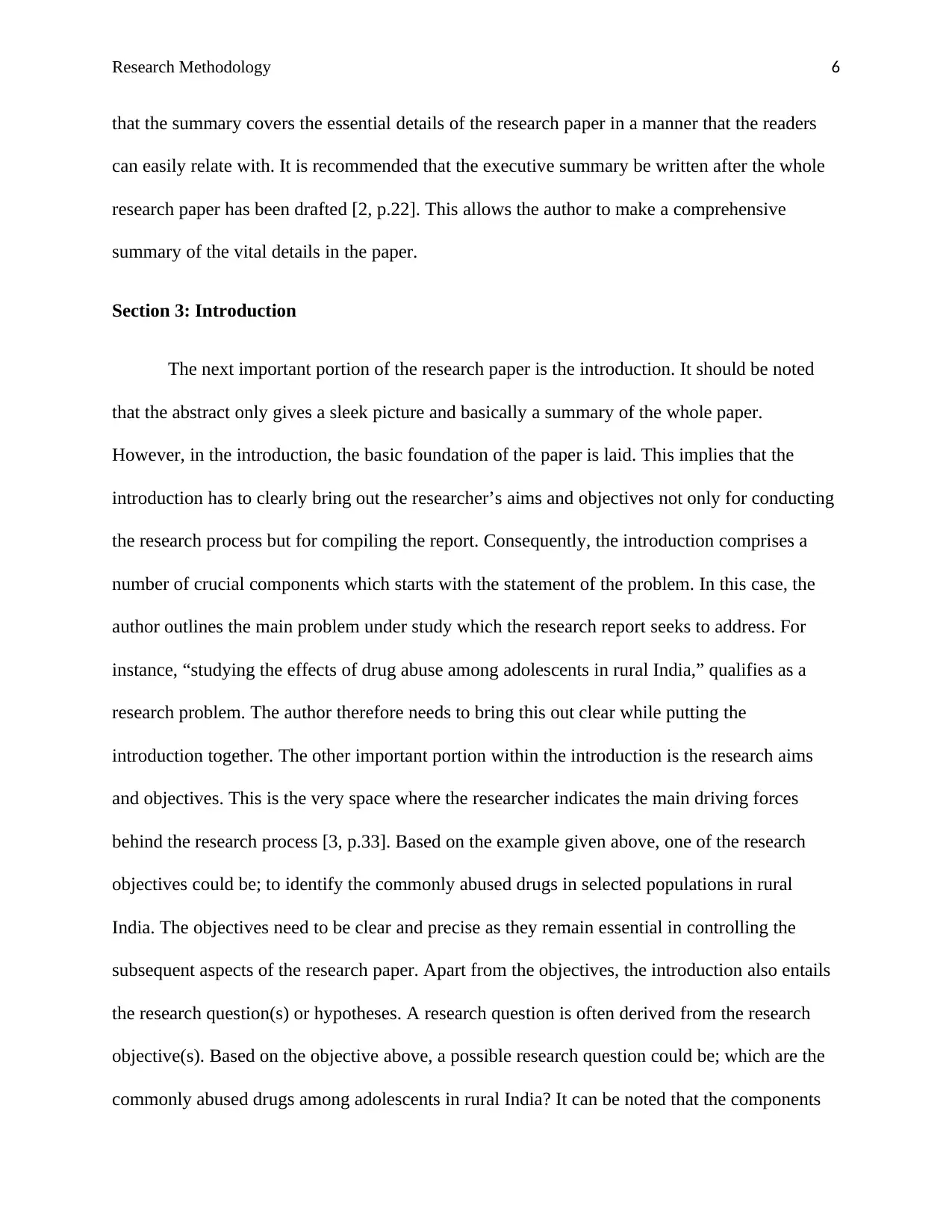
Research Methodology 6
that the summary covers the essential details of the research paper in a manner that the readers
can easily relate with. It is recommended that the executive summary be written after the whole
research paper has been drafted [2, p.22]. This allows the author to make a comprehensive
summary of the vital details in the paper.
Section 3: Introduction
The next important portion of the research paper is the introduction. It should be noted
that the abstract only gives a sleek picture and basically a summary of the whole paper.
However, in the introduction, the basic foundation of the paper is laid. This implies that the
introduction has to clearly bring out the researcher’s aims and objectives not only for conducting
the research process but for compiling the report. Consequently, the introduction comprises a
number of crucial components which starts with the statement of the problem. In this case, the
author outlines the main problem under study which the research report seeks to address. For
instance, “studying the effects of drug abuse among adolescents in rural India,” qualifies as a
research problem. The author therefore needs to bring this out clear while putting the
introduction together. The other important portion within the introduction is the research aims
and objectives. This is the very space where the researcher indicates the main driving forces
behind the research process [3, p.33]. Based on the example given above, one of the research
objectives could be; to identify the commonly abused drugs in selected populations in rural
India. The objectives need to be clear and precise as they remain essential in controlling the
subsequent aspects of the research paper. Apart from the objectives, the introduction also entails
the research question(s) or hypotheses. A research question is often derived from the research
objective(s). Based on the objective above, a possible research question could be; which are the
commonly abused drugs among adolescents in rural India? It can be noted that the components
that the summary covers the essential details of the research paper in a manner that the readers
can easily relate with. It is recommended that the executive summary be written after the whole
research paper has been drafted [2, p.22]. This allows the author to make a comprehensive
summary of the vital details in the paper.
Section 3: Introduction
The next important portion of the research paper is the introduction. It should be noted
that the abstract only gives a sleek picture and basically a summary of the whole paper.
However, in the introduction, the basic foundation of the paper is laid. This implies that the
introduction has to clearly bring out the researcher’s aims and objectives not only for conducting
the research process but for compiling the report. Consequently, the introduction comprises a
number of crucial components which starts with the statement of the problem. In this case, the
author outlines the main problem under study which the research report seeks to address. For
instance, “studying the effects of drug abuse among adolescents in rural India,” qualifies as a
research problem. The author therefore needs to bring this out clear while putting the
introduction together. The other important portion within the introduction is the research aims
and objectives. This is the very space where the researcher indicates the main driving forces
behind the research process [3, p.33]. Based on the example given above, one of the research
objectives could be; to identify the commonly abused drugs in selected populations in rural
India. The objectives need to be clear and precise as they remain essential in controlling the
subsequent aspects of the research paper. Apart from the objectives, the introduction also entails
the research question(s) or hypotheses. A research question is often derived from the research
objective(s). Based on the objective above, a possible research question could be; which are the
commonly abused drugs among adolescents in rural India? It can be noted that the components
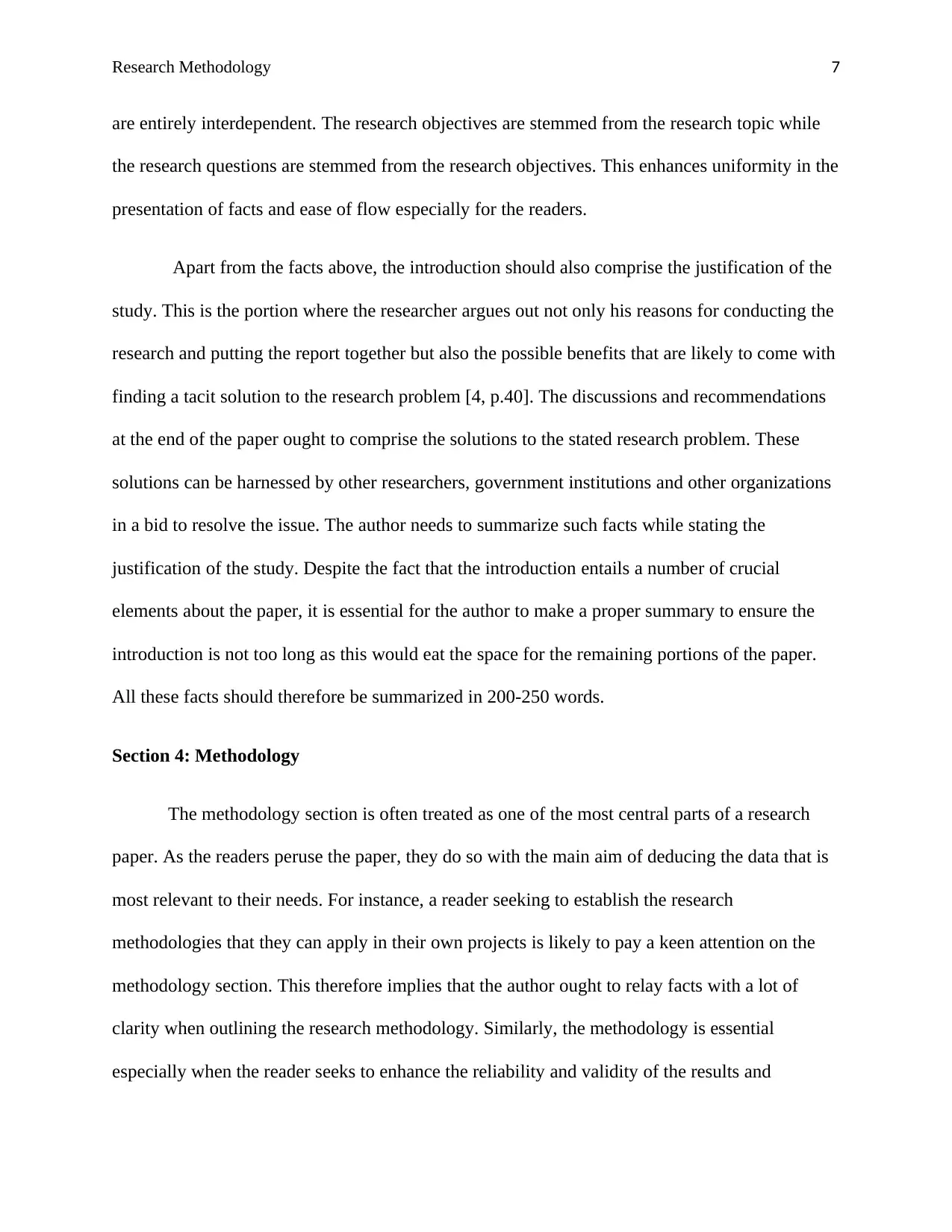
Research Methodology 7
are entirely interdependent. The research objectives are stemmed from the research topic while
the research questions are stemmed from the research objectives. This enhances uniformity in the
presentation of facts and ease of flow especially for the readers.
Apart from the facts above, the introduction should also comprise the justification of the
study. This is the portion where the researcher argues out not only his reasons for conducting the
research and putting the report together but also the possible benefits that are likely to come with
finding a tacit solution to the research problem [4, p.40]. The discussions and recommendations
at the end of the paper ought to comprise the solutions to the stated research problem. These
solutions can be harnessed by other researchers, government institutions and other organizations
in a bid to resolve the issue. The author needs to summarize such facts while stating the
justification of the study. Despite the fact that the introduction entails a number of crucial
elements about the paper, it is essential for the author to make a proper summary to ensure the
introduction is not too long as this would eat the space for the remaining portions of the paper.
All these facts should therefore be summarized in 200-250 words.
Section 4: Methodology
The methodology section is often treated as one of the most central parts of a research
paper. As the readers peruse the paper, they do so with the main aim of deducing the data that is
most relevant to their needs. For instance, a reader seeking to establish the research
methodologies that they can apply in their own projects is likely to pay a keen attention on the
methodology section. This therefore implies that the author ought to relay facts with a lot of
clarity when outlining the research methodology. Similarly, the methodology is essential
especially when the reader seeks to enhance the reliability and validity of the results and
are entirely interdependent. The research objectives are stemmed from the research topic while
the research questions are stemmed from the research objectives. This enhances uniformity in the
presentation of facts and ease of flow especially for the readers.
Apart from the facts above, the introduction should also comprise the justification of the
study. This is the portion where the researcher argues out not only his reasons for conducting the
research and putting the report together but also the possible benefits that are likely to come with
finding a tacit solution to the research problem [4, p.40]. The discussions and recommendations
at the end of the paper ought to comprise the solutions to the stated research problem. These
solutions can be harnessed by other researchers, government institutions and other organizations
in a bid to resolve the issue. The author needs to summarize such facts while stating the
justification of the study. Despite the fact that the introduction entails a number of crucial
elements about the paper, it is essential for the author to make a proper summary to ensure the
introduction is not too long as this would eat the space for the remaining portions of the paper.
All these facts should therefore be summarized in 200-250 words.
Section 4: Methodology
The methodology section is often treated as one of the most central parts of a research
paper. As the readers peruse the paper, they do so with the main aim of deducing the data that is
most relevant to their needs. For instance, a reader seeking to establish the research
methodologies that they can apply in their own projects is likely to pay a keen attention on the
methodology section. This therefore implies that the author ought to relay facts with a lot of
clarity when outlining the research methodology. Similarly, the methodology is essential
especially when the reader seeks to enhance the reliability and validity of the results and
Paraphrase This Document
Need a fresh take? Get an instant paraphrase of this document with our AI Paraphraser
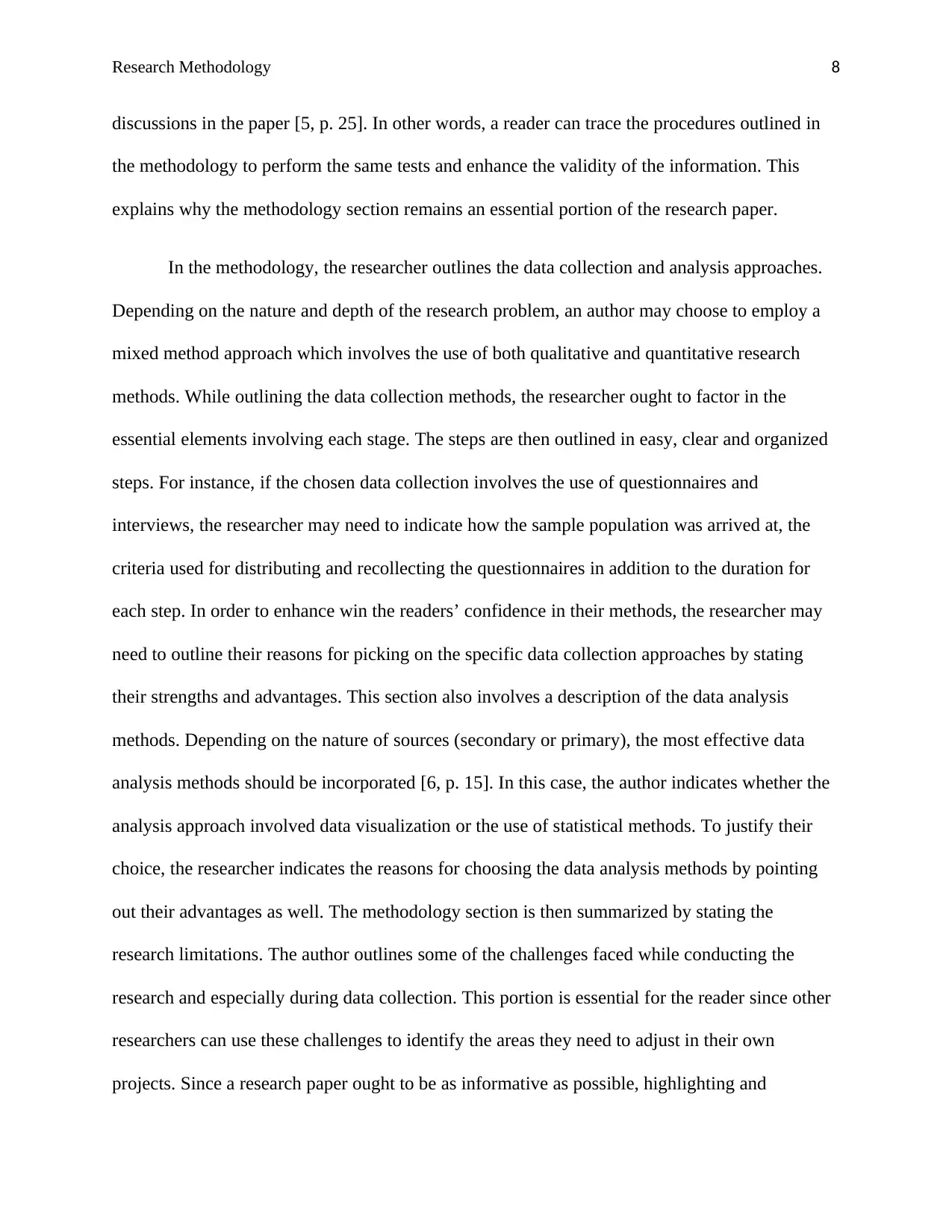
Research Methodology 8
discussions in the paper [5, p. 25]. In other words, a reader can trace the procedures outlined in
the methodology to perform the same tests and enhance the validity of the information. This
explains why the methodology section remains an essential portion of the research paper.
In the methodology, the researcher outlines the data collection and analysis approaches.
Depending on the nature and depth of the research problem, an author may choose to employ a
mixed method approach which involves the use of both qualitative and quantitative research
methods. While outlining the data collection methods, the researcher ought to factor in the
essential elements involving each stage. The steps are then outlined in easy, clear and organized
steps. For instance, if the chosen data collection involves the use of questionnaires and
interviews, the researcher may need to indicate how the sample population was arrived at, the
criteria used for distributing and recollecting the questionnaires in addition to the duration for
each step. In order to enhance win the readers’ confidence in their methods, the researcher may
need to outline their reasons for picking on the specific data collection approaches by stating
their strengths and advantages. This section also involves a description of the data analysis
methods. Depending on the nature of sources (secondary or primary), the most effective data
analysis methods should be incorporated [6, p. 15]. In this case, the author indicates whether the
analysis approach involved data visualization or the use of statistical methods. To justify their
choice, the researcher indicates the reasons for choosing the data analysis methods by pointing
out their advantages as well. The methodology section is then summarized by stating the
research limitations. The author outlines some of the challenges faced while conducting the
research and especially during data collection. This portion is essential for the reader since other
researchers can use these challenges to identify the areas they need to adjust in their own
projects. Since a research paper ought to be as informative as possible, highlighting and
discussions in the paper [5, p. 25]. In other words, a reader can trace the procedures outlined in
the methodology to perform the same tests and enhance the validity of the information. This
explains why the methodology section remains an essential portion of the research paper.
In the methodology, the researcher outlines the data collection and analysis approaches.
Depending on the nature and depth of the research problem, an author may choose to employ a
mixed method approach which involves the use of both qualitative and quantitative research
methods. While outlining the data collection methods, the researcher ought to factor in the
essential elements involving each stage. The steps are then outlined in easy, clear and organized
steps. For instance, if the chosen data collection involves the use of questionnaires and
interviews, the researcher may need to indicate how the sample population was arrived at, the
criteria used for distributing and recollecting the questionnaires in addition to the duration for
each step. In order to enhance win the readers’ confidence in their methods, the researcher may
need to outline their reasons for picking on the specific data collection approaches by stating
their strengths and advantages. This section also involves a description of the data analysis
methods. Depending on the nature of sources (secondary or primary), the most effective data
analysis methods should be incorporated [6, p. 15]. In this case, the author indicates whether the
analysis approach involved data visualization or the use of statistical methods. To justify their
choice, the researcher indicates the reasons for choosing the data analysis methods by pointing
out their advantages as well. The methodology section is then summarized by stating the
research limitations. The author outlines some of the challenges faced while conducting the
research and especially during data collection. This portion is essential for the reader since other
researchers can use these challenges to identify the areas they need to adjust in their own
projects. Since a research paper ought to be as informative as possible, highlighting and
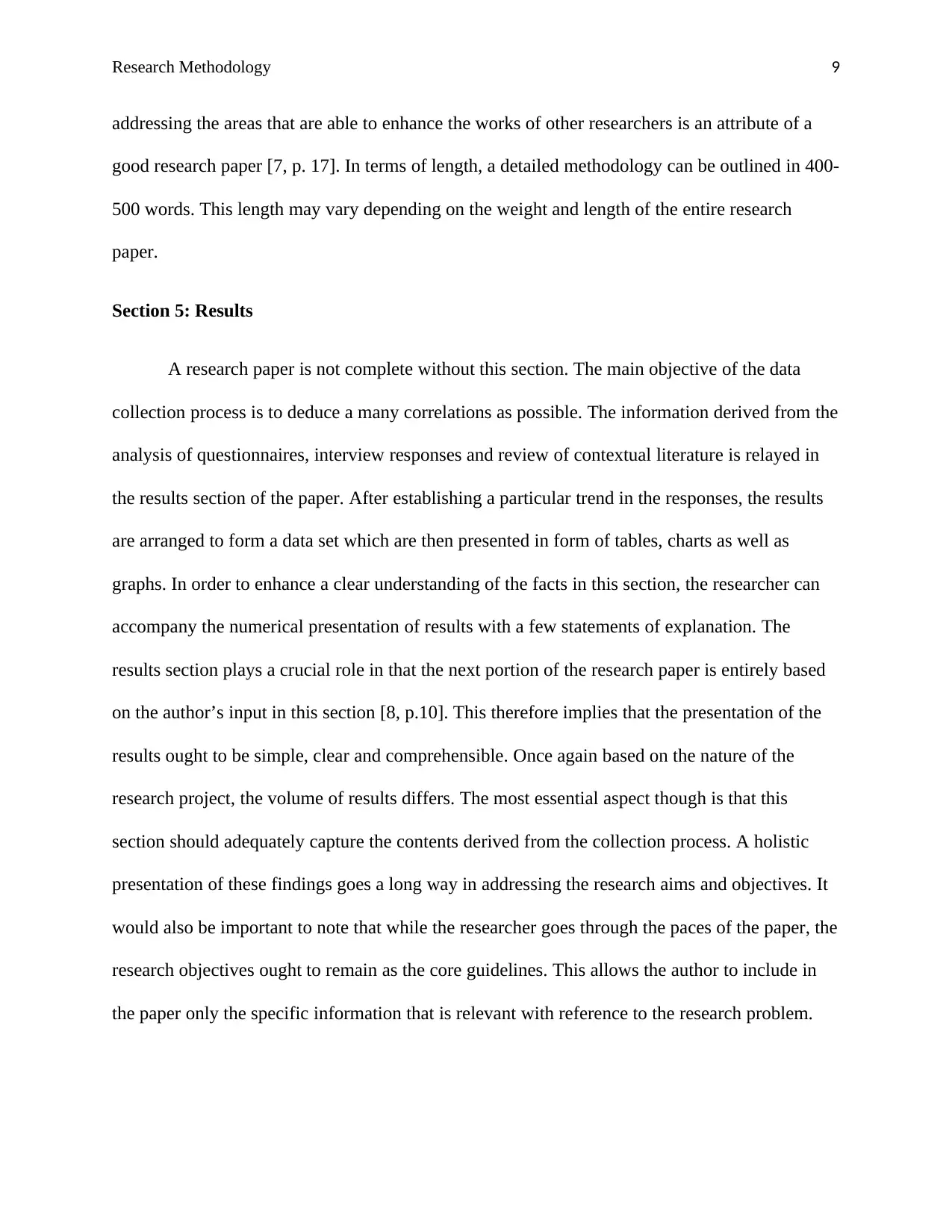
Research Methodology 9
addressing the areas that are able to enhance the works of other researchers is an attribute of a
good research paper [7, p. 17]. In terms of length, a detailed methodology can be outlined in 400-
500 words. This length may vary depending on the weight and length of the entire research
paper.
Section 5: Results
A research paper is not complete without this section. The main objective of the data
collection process is to deduce a many correlations as possible. The information derived from the
analysis of questionnaires, interview responses and review of contextual literature is relayed in
the results section of the paper. After establishing a particular trend in the responses, the results
are arranged to form a data set which are then presented in form of tables, charts as well as
graphs. In order to enhance a clear understanding of the facts in this section, the researcher can
accompany the numerical presentation of results with a few statements of explanation. The
results section plays a crucial role in that the next portion of the research paper is entirely based
on the author’s input in this section [8, p.10]. This therefore implies that the presentation of the
results ought to be simple, clear and comprehensible. Once again based on the nature of the
research project, the volume of results differs. The most essential aspect though is that this
section should adequately capture the contents derived from the collection process. A holistic
presentation of these findings goes a long way in addressing the research aims and objectives. It
would also be important to note that while the researcher goes through the paces of the paper, the
research objectives ought to remain as the core guidelines. This allows the author to include in
the paper only the specific information that is relevant with reference to the research problem.
addressing the areas that are able to enhance the works of other researchers is an attribute of a
good research paper [7, p. 17]. In terms of length, a detailed methodology can be outlined in 400-
500 words. This length may vary depending on the weight and length of the entire research
paper.
Section 5: Results
A research paper is not complete without this section. The main objective of the data
collection process is to deduce a many correlations as possible. The information derived from the
analysis of questionnaires, interview responses and review of contextual literature is relayed in
the results section of the paper. After establishing a particular trend in the responses, the results
are arranged to form a data set which are then presented in form of tables, charts as well as
graphs. In order to enhance a clear understanding of the facts in this section, the researcher can
accompany the numerical presentation of results with a few statements of explanation. The
results section plays a crucial role in that the next portion of the research paper is entirely based
on the author’s input in this section [8, p.10]. This therefore implies that the presentation of the
results ought to be simple, clear and comprehensible. Once again based on the nature of the
research project, the volume of results differs. The most essential aspect though is that this
section should adequately capture the contents derived from the collection process. A holistic
presentation of these findings goes a long way in addressing the research aims and objectives. It
would also be important to note that while the researcher goes through the paces of the paper, the
research objectives ought to remain as the core guidelines. This allows the author to include in
the paper only the specific information that is relevant with reference to the research problem.
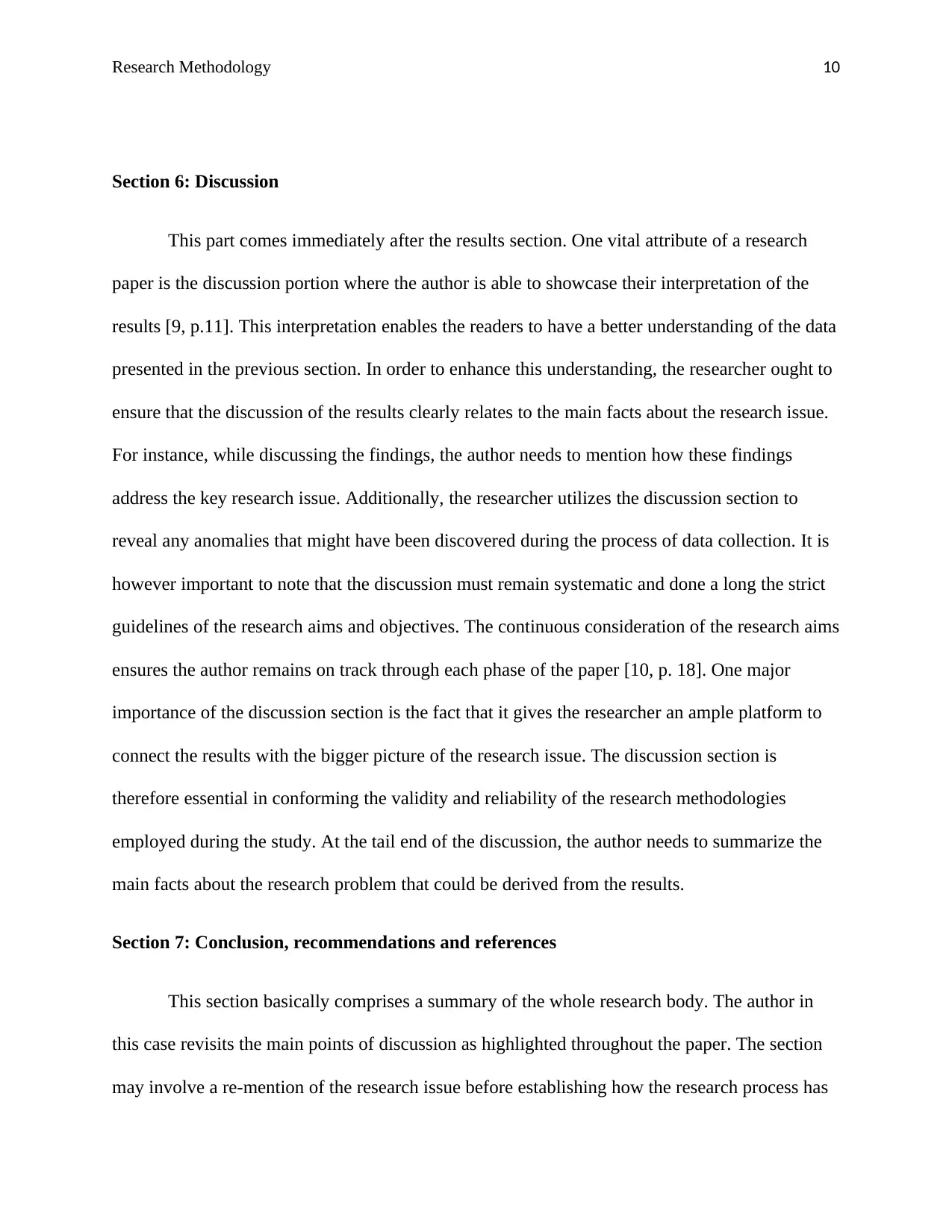
Research Methodology 10
Section 6: Discussion
This part comes immediately after the results section. One vital attribute of a research
paper is the discussion portion where the author is able to showcase their interpretation of the
results [9, p.11]. This interpretation enables the readers to have a better understanding of the data
presented in the previous section. In order to enhance this understanding, the researcher ought to
ensure that the discussion of the results clearly relates to the main facts about the research issue.
For instance, while discussing the findings, the author needs to mention how these findings
address the key research issue. Additionally, the researcher utilizes the discussion section to
reveal any anomalies that might have been discovered during the process of data collection. It is
however important to note that the discussion must remain systematic and done a long the strict
guidelines of the research aims and objectives. The continuous consideration of the research aims
ensures the author remains on track through each phase of the paper [10, p. 18]. One major
importance of the discussion section is the fact that it gives the researcher an ample platform to
connect the results with the bigger picture of the research issue. The discussion section is
therefore essential in conforming the validity and reliability of the research methodologies
employed during the study. At the tail end of the discussion, the author needs to summarize the
main facts about the research problem that could be derived from the results.
Section 7: Conclusion, recommendations and references
This section basically comprises a summary of the whole research body. The author in
this case revisits the main points of discussion as highlighted throughout the paper. The section
may involve a re-mention of the research issue before establishing how the research process has
Section 6: Discussion
This part comes immediately after the results section. One vital attribute of a research
paper is the discussion portion where the author is able to showcase their interpretation of the
results [9, p.11]. This interpretation enables the readers to have a better understanding of the data
presented in the previous section. In order to enhance this understanding, the researcher ought to
ensure that the discussion of the results clearly relates to the main facts about the research issue.
For instance, while discussing the findings, the author needs to mention how these findings
address the key research issue. Additionally, the researcher utilizes the discussion section to
reveal any anomalies that might have been discovered during the process of data collection. It is
however important to note that the discussion must remain systematic and done a long the strict
guidelines of the research aims and objectives. The continuous consideration of the research aims
ensures the author remains on track through each phase of the paper [10, p. 18]. One major
importance of the discussion section is the fact that it gives the researcher an ample platform to
connect the results with the bigger picture of the research issue. The discussion section is
therefore essential in conforming the validity and reliability of the research methodologies
employed during the study. At the tail end of the discussion, the author needs to summarize the
main facts about the research problem that could be derived from the results.
Section 7: Conclusion, recommendations and references
This section basically comprises a summary of the whole research body. The author in
this case revisits the main points of discussion as highlighted throughout the paper. The section
may involve a re-mention of the research issue before establishing how the research process has
Secure Best Marks with AI Grader
Need help grading? Try our AI Grader for instant feedback on your assignments.
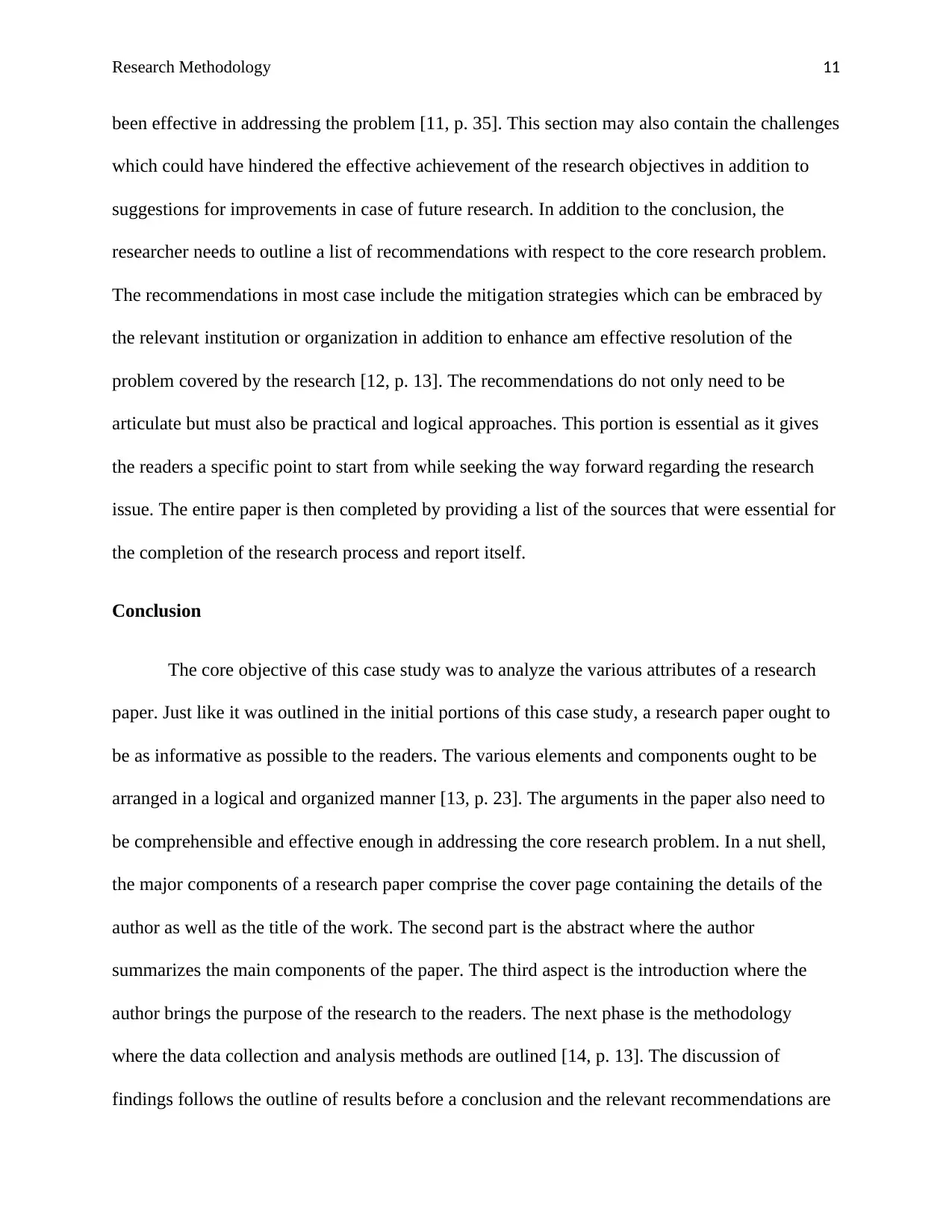
Research Methodology 11
been effective in addressing the problem [11, p. 35]. This section may also contain the challenges
which could have hindered the effective achievement of the research objectives in addition to
suggestions for improvements in case of future research. In addition to the conclusion, the
researcher needs to outline a list of recommendations with respect to the core research problem.
The recommendations in most case include the mitigation strategies which can be embraced by
the relevant institution or organization in addition to enhance am effective resolution of the
problem covered by the research [12, p. 13]. The recommendations do not only need to be
articulate but must also be practical and logical approaches. This portion is essential as it gives
the readers a specific point to start from while seeking the way forward regarding the research
issue. The entire paper is then completed by providing a list of the sources that were essential for
the completion of the research process and report itself.
Conclusion
The core objective of this case study was to analyze the various attributes of a research
paper. Just like it was outlined in the initial portions of this case study, a research paper ought to
be as informative as possible to the readers. The various elements and components ought to be
arranged in a logical and organized manner [13, p. 23]. The arguments in the paper also need to
be comprehensible and effective enough in addressing the core research problem. In a nut shell,
the major components of a research paper comprise the cover page containing the details of the
author as well as the title of the work. The second part is the abstract where the author
summarizes the main components of the paper. The third aspect is the introduction where the
author brings the purpose of the research to the readers. The next phase is the methodology
where the data collection and analysis methods are outlined [14, p. 13]. The discussion of
findings follows the outline of results before a conclusion and the relevant recommendations are
been effective in addressing the problem [11, p. 35]. This section may also contain the challenges
which could have hindered the effective achievement of the research objectives in addition to
suggestions for improvements in case of future research. In addition to the conclusion, the
researcher needs to outline a list of recommendations with respect to the core research problem.
The recommendations in most case include the mitigation strategies which can be embraced by
the relevant institution or organization in addition to enhance am effective resolution of the
problem covered by the research [12, p. 13]. The recommendations do not only need to be
articulate but must also be practical and logical approaches. This portion is essential as it gives
the readers a specific point to start from while seeking the way forward regarding the research
issue. The entire paper is then completed by providing a list of the sources that were essential for
the completion of the research process and report itself.
Conclusion
The core objective of this case study was to analyze the various attributes of a research
paper. Just like it was outlined in the initial portions of this case study, a research paper ought to
be as informative as possible to the readers. The various elements and components ought to be
arranged in a logical and organized manner [13, p. 23]. The arguments in the paper also need to
be comprehensible and effective enough in addressing the core research problem. In a nut shell,
the major components of a research paper comprise the cover page containing the details of the
author as well as the title of the work. The second part is the abstract where the author
summarizes the main components of the paper. The third aspect is the introduction where the
author brings the purpose of the research to the readers. The next phase is the methodology
where the data collection and analysis methods are outlined [14, p. 13]. The discussion of
findings follows the outline of results before a conclusion and the relevant recommendations are

Research Methodology 12
given. The final portion comprises a list of the sources used during the research [15, p. 9]. Each
of these parts needs to be clear and effectively arranged to make the standard format of a
research paper.
given. The final portion comprises a list of the sources used during the research [15, p. 9]. Each
of these parts needs to be clear and effectively arranged to make the standard format of a
research paper.
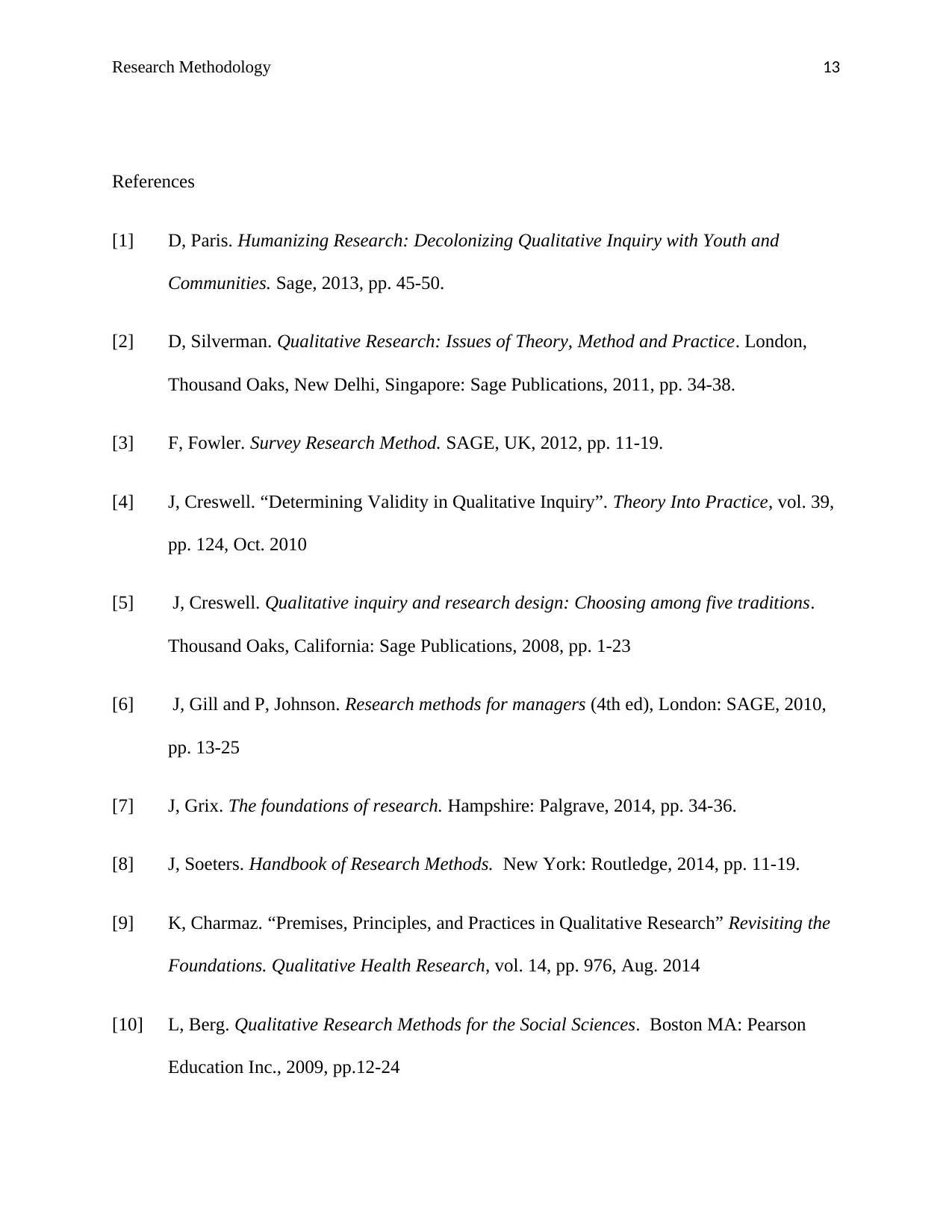
Research Methodology 13
References
[1] D, Paris. Humanizing Research: Decolonizing Qualitative Inquiry with Youth and
Communities. Sage, 2013, pp. 45-50.
[2] D, Silverman. Qualitative Research: Issues of Theory, Method and Practice. London,
Thousand Oaks, New Delhi, Singapore: Sage Publications, 2011, pp. 34-38.
[3] F, Fowler. Survey Research Method. SAGE, UK, 2012, pp. 11-19.
[4] J, Creswell. “Determining Validity in Qualitative Inquiry”. Theory Into Practice, vol. 39,
pp. 124, Oct. 2010
[5] J, Creswell. Qualitative inquiry and research design: Choosing among five traditions.
Thousand Oaks, California: Sage Publications, 2008, pp. 1-23
[6] J, Gill and P, Johnson. Research methods for managers (4th ed), London: SAGE, 2010,
pp. 13-25
[7] J, Grix. The foundations of research. Hampshire: Palgrave, 2014, pp. 34-36.
[8] J, Soeters. Handbook of Research Methods. New York: Routledge, 2014, pp. 11-19.
[9] K, Charmaz. “Premises, Principles, and Practices in Qualitative Research” Revisiting the
Foundations. Qualitative Health Research, vol. 14, pp. 976, Aug. 2014
[10] L, Berg. Qualitative Research Methods for the Social Sciences. Boston MA: Pearson
Education Inc., 2009, pp.12-24
References
[1] D, Paris. Humanizing Research: Decolonizing Qualitative Inquiry with Youth and
Communities. Sage, 2013, pp. 45-50.
[2] D, Silverman. Qualitative Research: Issues of Theory, Method and Practice. London,
Thousand Oaks, New Delhi, Singapore: Sage Publications, 2011, pp. 34-38.
[3] F, Fowler. Survey Research Method. SAGE, UK, 2012, pp. 11-19.
[4] J, Creswell. “Determining Validity in Qualitative Inquiry”. Theory Into Practice, vol. 39,
pp. 124, Oct. 2010
[5] J, Creswell. Qualitative inquiry and research design: Choosing among five traditions.
Thousand Oaks, California: Sage Publications, 2008, pp. 1-23
[6] J, Gill and P, Johnson. Research methods for managers (4th ed), London: SAGE, 2010,
pp. 13-25
[7] J, Grix. The foundations of research. Hampshire: Palgrave, 2014, pp. 34-36.
[8] J, Soeters. Handbook of Research Methods. New York: Routledge, 2014, pp. 11-19.
[9] K, Charmaz. “Premises, Principles, and Practices in Qualitative Research” Revisiting the
Foundations. Qualitative Health Research, vol. 14, pp. 976, Aug. 2014
[10] L, Berg. Qualitative Research Methods for the Social Sciences. Boston MA: Pearson
Education Inc., 2009, pp.12-24
Paraphrase This Document
Need a fresh take? Get an instant paraphrase of this document with our AI Paraphraser
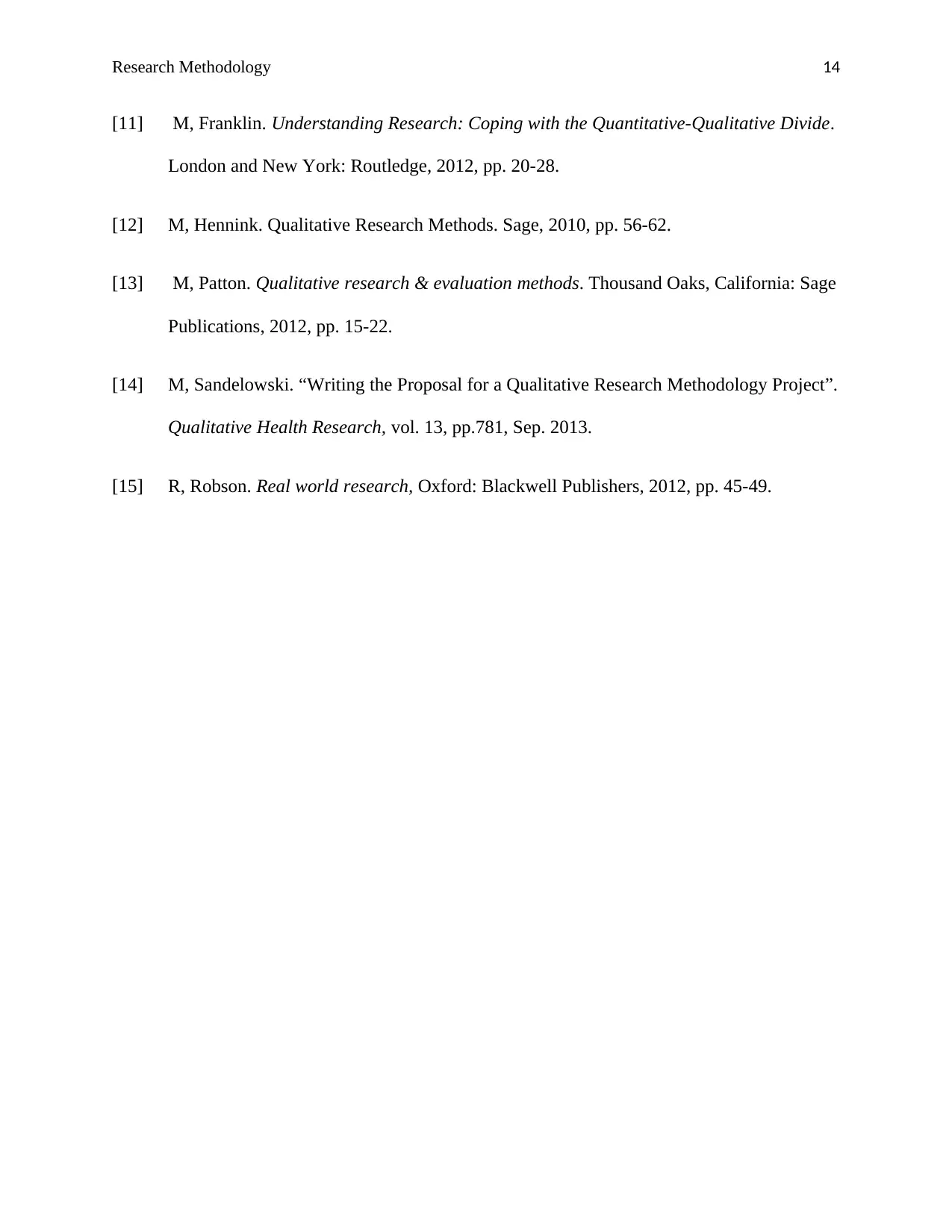
Research Methodology 14
[11] M, Franklin. Understanding Research: Coping with the Quantitative-Qualitative Divide.
London and New York: Routledge, 2012, pp. 20-28.
[12] M, Hennink. Qualitative Research Methods. Sage, 2010, pp. 56-62.
[13] M, Patton. Qualitative research & evaluation methods. Thousand Oaks, California: Sage
Publications, 2012, pp. 15-22.
[14] M, Sandelowski. “Writing the Proposal for a Qualitative Research Methodology Project”.
Qualitative Health Research, vol. 13, pp.781, Sep. 2013.
[15] R, Robson. Real world research, Oxford: Blackwell Publishers, 2012, pp. 45-49.
[11] M, Franklin. Understanding Research: Coping with the Quantitative-Qualitative Divide.
London and New York: Routledge, 2012, pp. 20-28.
[12] M, Hennink. Qualitative Research Methods. Sage, 2010, pp. 56-62.
[13] M, Patton. Qualitative research & evaluation methods. Thousand Oaks, California: Sage
Publications, 2012, pp. 15-22.
[14] M, Sandelowski. “Writing the Proposal for a Qualitative Research Methodology Project”.
Qualitative Health Research, vol. 13, pp.781, Sep. 2013.
[15] R, Robson. Real world research, Oxford: Blackwell Publishers, 2012, pp. 45-49.
1 out of 14
Related Documents
Your All-in-One AI-Powered Toolkit for Academic Success.
+13062052269
info@desklib.com
Available 24*7 on WhatsApp / Email
![[object Object]](/_next/static/media/star-bottom.7253800d.svg)
Unlock your academic potential
© 2024 | Zucol Services PVT LTD | All rights reserved.





